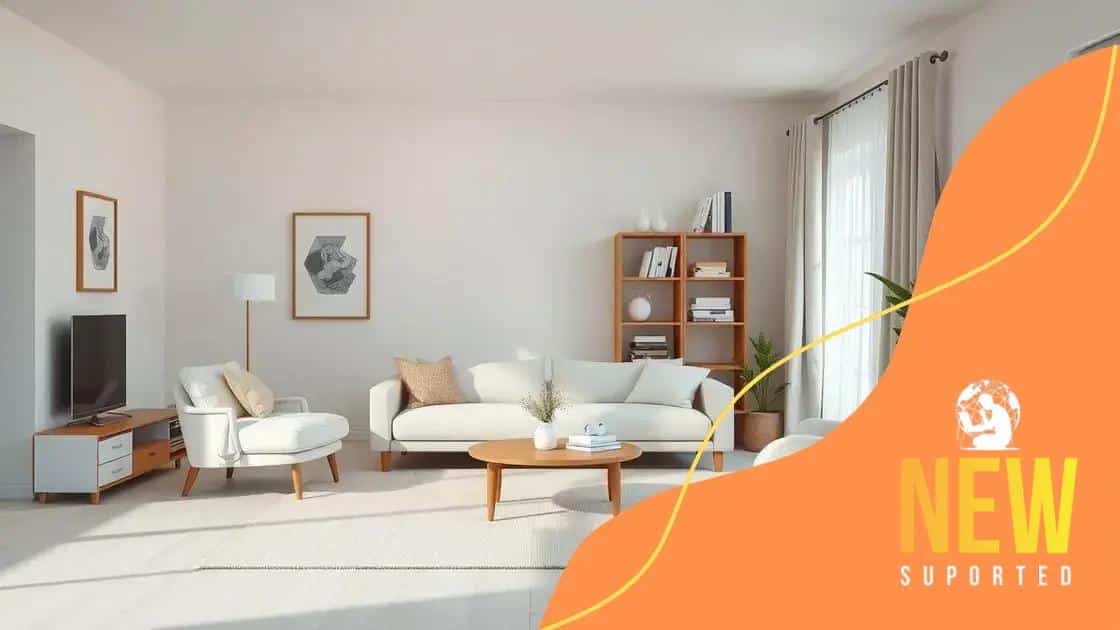How to create a minimalist home design in 2025

To create a minimalist home design in 2025, focus on multifunctional furniture, a neutral color palette, and incorporate personal touches to reflect your style while maximizing space effectively.
How to create a minimalist home design in 2025 is more than just an aesthetic choice. It’s about embracing simplicity and functionality. Have you ever felt overwhelmed by clutter? Let’s dive into how a minimalist approach can transform your space and life.
Understanding minimalist design principles
Understanding the minimalist design principles is essential for achieving a streamlined and peaceful home. Minimalism emphasizes simplicity and functionality, which creates an inviting atmosphere.
One key principle of minimalist design is the idea of “less is more.” This means focusing on fewer items but choosing those that offer high utility and beauty. By reducing clutter, you create a more open and calming environment.
Emphasizing Functionality
In a minimalist home, every piece should have a purpose. This approach encourages thoughtful selection of furniture and decor. You can opt for pieces that serve multiple functions, like a sofa that also folds into a guest bed.
Neutral Color Palettes
Another important aspect is using neutral color palettes. Shades like white, gray, and beige create a soothing backdrop, allowing the few decorative items to stand out.
- Avoid bold patterns and colors that can overwhelm a space.
- Use natural materials like wood and stone for warmth.
- Incorporate greenery with plants to invigorate the space.
Incorporating natural light is also a vital part of minimalist design. Large windows and open spaces enable light to flow freely, which enhances the feeling of openness. Consider window treatments that allow flexibility to control the amount of sunlight.
Finally, remember that minimalist design is also about personal expression. Choose a few cherished items that reflect your identity, keeping them as focal points in your room without cluttering the space. This balance between simplicity and personality leads to a well-designed, minimalist home that feels uniquely yours.
Choosing the right colors and materials
Choosing the right colors and materials is crucial in minimalist home design. The right selection creates a harmonious atmosphere and reflects your personal style. A well-thought-out color scheme can transform a room, making it feel open and inviting.
When it comes to color, start with a neutral palette. Shades like white, beige, and soft gray set a calming backdrop. These colors are not only timeless but also enable you to incorporate accents without overwhelming the space. Adding a pop of color through accessories or artwork can provide visual interest.
Material Selection
Materials play a vital role in enhancing the minimalist aesthetic. Opt for natural substances such as wood, stone, and metal. These elements add warmth and texture while keeping things simple. For example, a wooden dining table paired with metal chairs creates an elegant yet relaxed vibe.
- Natural materials bring a sense of serenity and comfort.
- Textures enhance visual appeal without adding clutter.
- Consider sustainable options for an eco-friendly home.
In addition, think about the finish of materials. Matte finishes often feel more modern and understated compared to glossy ones. This choice helps in maintaining a cohesive look throughout your space. Balancing different textures is essential as well; combining smooth surfaces with rough ones creates depth without chaos.
Don’t forget about the importance of light. A room’s natural light can significantly affect how colors and materials appear. Test swatches of paint and fabric in different lighting before making a final decision. This practice ensures that your selected colors align perfectly with your vision for a peaceful, minimalist home.
Maximizing space in small homes

Maximizing space in small homes is vital for creating an efficient and comfortable living environment. With the right strategies, even the tiniest areas can feel spacious and functional. Start by thinking about how each room can serve multiple purposes.
Consider using versatile furniture that adapts to your needs. For example, a foldable dining table can be expanded for meals and tucked away when not in use. This flexibility allows you to use your space more effectively.
Utilizing Vertical Space
Another effective method is to utilize vertical space. Shelves can help you organize books and decorative items without taking up floor space. Hang shelves high on the walls to draw the eyes upward, creating an illusion of height in the room.
- Choose tall bookcases that extend close to the ceiling.
- Use hooks or racks for hanging items like bicycles or coats.
- Install cabinets that reach the ceiling for extra storage.
Using mirrors is another popular technique in small spaces. A large mirror can reflect light and create a feeling of depth, making the room appear larger than it is. Place mirrors across from windows to maximize natural light.
When it comes to color, light hues can enhance the sense of openness. Opt for soft whites, light grays, and pastels to make the space feel airy. Avoid dark colors that can make rooms feel cramped. Also, consider incorporating built-in furniture, which seamlessly blends with the design and minimizes clutter.
Organizing your belongings is crucial for maximizing space. Invest in storage solutions like bins, baskets, and under-bed boxes to keep items out of sight while remaining accessible. This strategy helps maintain a clean and organized environment, enhancing your small home’s overall appeal.
Incorporating multifunctional furniture
Incorporating multifunctional furniture is a smart way to enhance the utility of your space while maintaining a minimalist design. This approach allows you to maximize functionality without cluttering your home. Furniture pieces that serve more than one purpose can significantly improve how you use your limited space.
For example, a sofa bed serves as both a comfortable couch during the day and a cozy bed at night. This duality is perfect for smaller apartments where every square foot counts. Similarly, consider a coffee table that has built-in storage. It keeps the area neat while providing a place to store books or magazines.
Designing with Purpose
When selecting multifunctional furniture, focus on designs that complement your decor and enhance the aesthetic appeal of your home. Choose pieces that are stylish yet practical. A dining table that extends for guests can be a beautiful centerpiece while serving its function.
- Choose ottomans that double as storage units.
- Look for foldable desks that can be hidden away when not in use.
- Consider nesting tables that can be separated or kept together.
In addition, prioritize lightweight furniture for flexibility. Having lightweight items allows you to rearrange your space easily based on your needs. A movable workspace can be essential in cramped areas, letting you adapt your living space for different activities like work or leisure.
Another aspect to keep in mind is the quality and durability of the materials. Invest in well-made multifunctional items that can withstand daily wear and tear. This ensures that your furniture remains a lasting element of your minimalist home, serving you effectively for years to come.
Adding personal touches to your design
Adding personal touches to your design is what makes a home truly feel like yours. While minimalism emphasizes simplicity, it’s important to include elements that reflect your personality and style. These pieces can create warmth and a sense of belonging in your space.
Start by displaying a few cherished items, such as family photos or artwork that inspires you. These personal mementos can be showcased in simple frames on shelves or walls without overwhelming the minimalist aesthetic. A single statement piece can act as a focal point, drawing attention while maintaining the overall clean look.
Incorporating Color and Texture
To make your design more personal, consider incorporating color and texture through accessories. Soft throw pillows or a cozy blanket add warmth and invite relaxation. Choose colors that resonate with you without clashing with your neutral background.
- Pick a few accent colors to use in decoration.
- Select rugs that feel comfortable and visually appealing.
- Add plants for a touch of nature and vitality.
Additionally, consider customizing furniture or decor items. This could include choosing unique fabrics for upholstered pieces or adding a personal design element to shelves and tables. The goal is to enhance your space while ensuring that it remains functional and minimal.
Remember that less is often more in a minimalist setting. Select a few items that hold meaning for you rather than overcrowding the space. Each piece should contribute to the story of your home, creating a balance between minimalism and personal expression. This thoughtful approach allows your design to feel both intentional and inviting.
In conclusion, creating a minimalist home that reflects your style is an achievable goal. By focusing on functional furniture, neutral colors, and incorporating personal touches, you can design a space that is both welcoming and efficient. Remember, the essence of minimalism is not about having less, but about making space for what truly matters to you. Embrace simplicity, and let your personality shine through in your design choices.
FAQ – Frequently Asked Questions about Minimalist Home Design
What is the essence of minimalist home design?
The essence of minimalist design is to create a space that is functional and aesthetically pleasing by reducing clutter and focusing on essential items.
How can I incorporate personal touches in a minimalist home?
You can add personal touches by displaying meaningful decor, using accent colors, and choosing furniture that reflects your style.
What types of furniture are best for small spaces?
Multifunctional furniture, such as sofa beds, storage ottomans, and foldable tables, are ideal for maximizing space in small homes.
How do I choose the right colors for a minimalist design?
Opt for neutral colors that create an inviting atmosphere while allowing you to incorporate subtle accent colors through decor.






